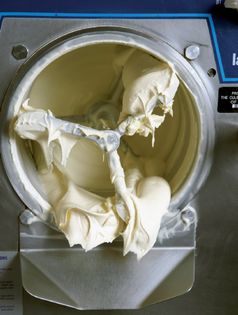Advertisement
Batch Freezer Machines
Published 2008

When the machine is turned on, a blade spins inside the barrel at a constant speed. This whips the mixture, which introduces air bubbles into the base as it freezes, trapping them to give it its characteristic texture. The faster the blade spins, the smaller the resulting bubbles and ice crystals. Machines that spin too fast need to be continuously supervised to avoid overwhipping the base, which will add too much air and freeze the product too much. Conversely, machines that spin too slowly, like most home units, will produce large crystals and will introduce very little air into the product. When it spins, the blade needs to come into direct contact with the surface of the barrel so the blade will scrape off the ice crystals that form there before they get too large. The blade will mix the crystals into the remainder of the base through its spinning motion, thus creating even-size crystals and even freezing. The blade needs to be of a nonreactive material, such as heavy-duty plastic, so as to not cause an unwanted chemical reaction that could be a health hazard.


